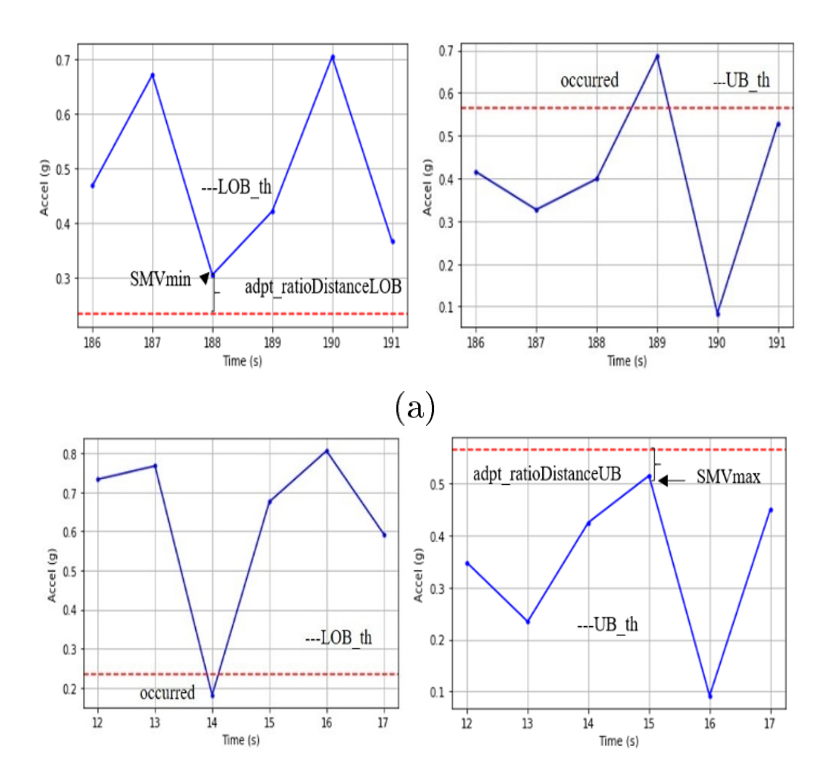Identification of Soft Fall based on Falling State Occurrences
Main Article Content
Abstract
Fall detection techniques for helping the elderly were developed based on identifying falling states using simulated falls. However, some real-life falling states were left undetected, which led to this work on analysing falling states. The aim was to find the differences between active daily living and soft falls where falling states were undetected. This is the first consideration to be based on the threshold-based algorithms using the acceleration data stored in an activity database. This study addresses soft falls in addition to the general falls based on two falling states. Despite the number of false alarms being higher rising from 18.5% to 56.5%, the sensitivity was increased from 52% to 92.5% for general falls, and from 56% to 86% for soft falls. Our experimental results show the importance of state occurrence for soft fall detection, and will be used to build a learning model for soft fall detection.
Article Details

This work is licensed under a Creative Commons Attribution-NonCommercial-NoDerivatives 4.0 International License.
References
World Health Organization, “WHO Global Report on Falls Prevention in Older Age.,” Community Health (Bristol)., Geneva: World Health Organization, 2007.
A. Stinchcombe, N. Kuran, and S. Powell, “Seniors’ Falls in Canada”, Public Health Agency of Canada, Vol. 34, No. 2–3, pp. 171-174, Jul. 2014.
S. R. Lord and C. Sherrington, “Falls in older people risk factors and strategies for prevention,” Aging and Society, Vol. 21, No. 5, pp. 667-675, 2001.
M. E. Tinetti, W. L. Liu, and E. B. Claus, “Predictors and prognosis of inability to get up after falls among elderly persons,” JAMA J. Am. Med. Assoc., Vol. 269, No. 1, pp. 65-70, 1993.
D. Wild, U. S. L. Nayak, and B. Isaacs, “How dangerous are falls in old people at home?,” Br. Med. J. (Clin. Res. Ed)., Vol. 282, No. 6260, pp. 266-268, 1981.
D. Litvak, I. Gannot, “Detection of falls at home using floor vibrations and sound”, in 2008 IEEE 25th Convention of Electrical and Electronics Engineers in Israel (Ieeei 2008), pp. 514-518, 2008.
M. Cheffena, “Fall detection using smartphone audio features,” IEEE J. Biomed Health Inform, Vol. 20, No. 4, pp. 1073-1080, 2016.
M. Kepski and B. Kwolek, “Fall detection using ceiling-mounted 3D depth camera,” in Int. Conf. on Computer Vision Theory and Applications (VISAPP), Vol. 2, pp. 640-647, 2013.
X. Yang, F. Xiong, Y. Shao, and Q. Niu, “WmFall: WiFi-based multistage fall detection with channel state information,” Int. J. Distrib. Sens. Networks, Vol. 14, No. 10, 2018.
A. T. Ozdemir and B. Barshan, “Detecting falls with wearable sensors using machine learning techniques,” Sensors, Vol. 14, No. 6, pp.10691-10708, 2014.
O. Kerdjidj, N. Ramzan, K. Ghanem, A. Amira, and F. Chouireb, “Fall detection and human activity classification using wearable sensors and compressed sensing,” J. Ambient Intell. Humaniz. Comput., pp. 1-13, 2019.
N. Pannurat, S. Thiemjarus, and E. Nantajeewarawat, “A hybrid temporal reasoning framework for fall monitoring,”, IEEE Sens. J., Vol. 17, No. 6, pp. 1749-1759, 2017.
D. Genoud and V. Cuendet, “Soft fall detection using machine learning in wearable devices,”, in 2016 IEEE 30th Int. Conf. on Advanced Information Networking and Applications (AINA), pp. 501-505, 2016.
F. Hussain, F. Hussain, M. Ehatisham-Ul-Haq, and M. A. Azam, “Activity-Aware Fall Detection and Recognition Based on Wearable Sensors,” IEEE Sens. J., Vol. 19, No. 12, pp. 4528–4536, 2019.
M. Kangas, A. Konttila, P. Lindgren, I. Winblad, and T. Jämsä, “Comparison of low-complexity fall detection algorithms for body attached accelerometers,” Gait Posture, Vol. 28, No. 2, pp. 285-291, 2008.
A. K. Bourke, J. V. O. Brien, and G. M. Lyons, “Evaluation of a threshold-based tri-axial accelerometer fall detection algorithm,” Gait Posture, Vol. 26, No. 2, pp. 194-199, 2007.
J. K. Lee, S. N. Robinovitch, and E. J. Park, “Inertial sensing-based pre-impact detection of falls involving near-fall scenarios,” IEEE Trans. Neural Syst. Rehabil. Eng., Vol. 23, No. 2, pp. 258-266, 2015.
P. Pierleoni et al., “A wearable fall detector for elderly people based on AHRS and Barometric sensor,” IEEE Sens. J., Vol. 16, No. 17, pp. 6733-6744, 2016.
F.Bagala, C. Becker et al., “Evaluation of accelerometer-based fall detection algorithms on real-world falls,” PLoS One, Vol. 7, No. 5, pp, 1-9, 2012.
P. V. Er and K. K. Tan, “Non-intrusive fall detection monitoring for the elderly based on fuzzy logic,” Meas. J. Int. Meas. Confed., Vol. 124, July 2017, pp. 91–102, 2018.
P. Pierleoni, A. Belli, L. Palma, M. Pellegrini, L. Pernini, and S. Valenti, “A High Reliability Wearable Device for Elderly Fall Detection,” IEEE Sens. J., Vol. 15, No. 8, pp. 4544–4553, 2015.
T. Kyaw, A. Choksuriwong, N. Suvonvorn, “Soft Fall Detection using Multi-sensors,” Asia Pacific Conference on Robot IoT System Development and Platform 2018 (APRIS2018), pp. 52–53, 2018.
C. Medrano, R. Igual, I. Plaza, and M. Castro, “Detecting falls as novelties in acceleration patterns acquired with smartphones,” PLoS One, Vol. 9, No. 4, 2014.
G. Vavoulas, M. Pediaditis, E. G. Spanakis, and M. Tsiknakis, “The MobiFall dataset: An initial evaluation of fall detection algorithms using smartphones,” 13th IEEE Int. Conf. Bioinformatics and Bioengineering, pp. 1–4, 2013.
M. Kangas, A. Konttila, I. Winblad, and T. Jämsä, “Determination of simple thresholds for accelerometry-based parameters for fall detection,” 29th Annu. Int. Conf. IEEE Engineering in Medicine and Biology (IEEE EMBS), pp. 1367–1370, 2007.
E. Casilari, J. A. Santoyo-Ramón, and J. M. Cano-García, “Analysis of public datasets for wearable fall detection systems,” Sensors (Switzerland), Vol. 17, No. 7, 2017.
B. Cates, T. Sim, H. M. Heo, B. Kim, H. Kim, and J. H. Mun, “A novel detection model and its optimal features to classify falls from low- and high-acceleration activities of daily life using an insole sensor system,” Sensors (Switzerland), Vol. 18, No. 4, 2018.


